Picturing Venus
Introduction
Picturing Venus
9 March - 29 June 2014
Hunterian Art Gallery
Admission free
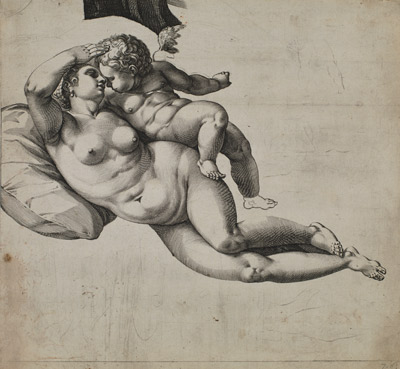 The ancient Roman goddess Venus, known as Aphrodite in Greek, features prominently in Renaissance art as a symbol of female beauty. This In-Focus display, a collaboration with the University's History of Art department, presents new research examining the occurrence of Venus’s image in art and the myths associated with her.
The ancient Roman goddess Venus, known as Aphrodite in Greek, features prominently in Renaissance art as a symbol of female beauty. This In-Focus display, a collaboration with the University's History of Art department, presents new research examining the occurrence of Venus’s image in art and the myths associated with her.
Picturing Venus features some of the most beautiful engravings from the Hunterian collection, including such masterpieces as Dürer’s Adam and Eve of 1504 and Marcantonio’s Judgement of Paris of c.1510. The selection also documents how the image of Venus was prized and used in the earliest art academies, in the form of plaster casts, drawings and, most effectively of all, engravings.
At the centre of the display is a statue of Venus, on loan from The Glasgow School of Art, which demonstrates how plaster casts from the antique still promote the Renaissance notion explored in this display: that classical sculpture provides our ideal images of human beauty.
Image: Jan Muller, Venus and Cupid.
Engraving
Engraving
Engravings are printed from incised copper plates. The engraver’s tool, the burin, is a square-sectioned steel rod, cut off obliquely to form a diamond-shaped point. It is pushed ahead of the hand and throws up a curling sliver of metal; great skill is required. The plate is printed by forcing ink into the lines and wiping off the surface ink. With a dampened sheet of paper placed on top, plate and paper are squeezed together in a double rolling press to create the print.
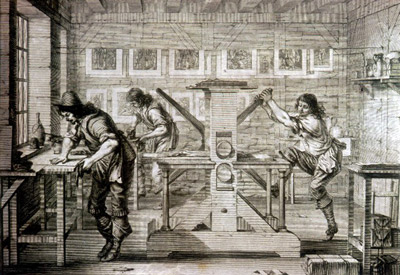 Engraving developed as an art-form in the mid-15th century, at about the same time as the invention of printing with moveable type. The expanding market for books meant an increase in production and a lowering of the price of paper. This gave a stimulus to the makers of printed images, whether the cheap hand-coloured woodcuts sold at Christian shrines or the more expensive engravings that some great artists made as a commercial exploitation of their studio imagery.
Engraving developed as an art-form in the mid-15th century, at about the same time as the invention of printing with moveable type. The expanding market for books meant an increase in production and a lowering of the price of paper. This gave a stimulus to the makers of printed images, whether the cheap hand-coloured woodcuts sold at Christian shrines or the more expensive engravings that some great artists made as a commercial exploitation of their studio imagery.
Renaissance artists were significant buyers of these prints, which they acquired to extend their knowledge of figure drawing, composition and stories from the Greek and Roman world. These images show how the archaeological focus of artists working around 1500 established Venus as the idealised embodiment of beauty in the female nude. Venus rapidly became the emblem of art itself.
Image: Abraham Bosse, The Printing of Engraving, 1642
Art and Beauty
Venus: Art and Beauty
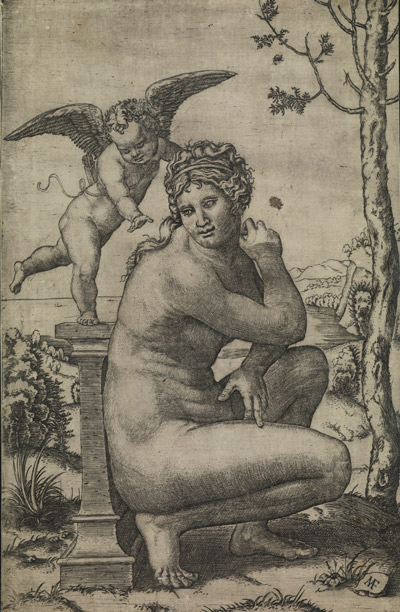 The ancient Roman goddess Venus, known as Aphrodite in Greek, was among the earliest as well as the most enduring of archaic divinities. Her first manifestations are as a fertility goddess whose worship was thought to vouchsafe plenitude.
The ancient Roman goddess Venus, known as Aphrodite in Greek, was among the earliest as well as the most enduring of archaic divinities. Her first manifestations are as a fertility goddess whose worship was thought to vouchsafe plenitude.
From this evolved her identity as the goddess of love and desire. This was embodied in representations of the life-size female nude made by classical Greek sculptors in the period c.500-350 B.C.
These idealised figures were understood as forms of perfected beauty in art, and were widely imitated by Roman sculptors in the period 200 B.C. – 100 A.D. Thus Venus came to denote the beauty of art, transforming her viewer into an art-lover. Renaissance printmakers used the well-known poses of ancient Venus statues to signal a figure of great artistic beauty in their work.
Image: Marcantonio Raimondi, Crouching Venus.
Imitations
Imitating Venus
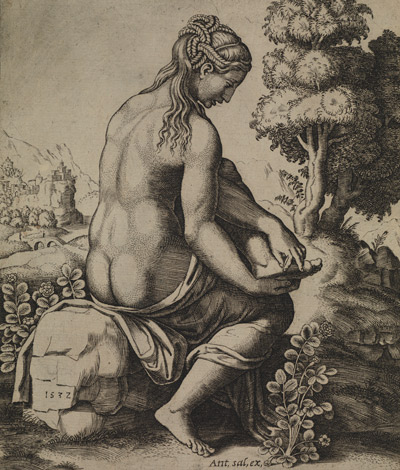 As the measure of female beauty in art, the forms of Venus inherited from antiquity became the touchstone of ideal beauty throughout the Renaissance.
As the measure of female beauty in art, the forms of Venus inherited from antiquity became the touchstone of ideal beauty throughout the Renaissance.
Ancient sculpture had represented Venus in a series of poses that became canonical – crouching, seated, or standing with her weight on one leg, her arms shielding her body – and these were widely imitated by Renaissance painters and printmakers who rendered her from a succession of viewpoints.
They further embellished the theme of her beauty in art by ornamenting her femininity with flowers, lush gardens and verdant landscapes, or through a counterpoint with heroic male nudes and sweetly playful cupids. The artistic skill and beauty of a print was seen to lie in its ability to translate the visual effects of painting and sculpture into the inky black lines of an engraving.
Image: Master of the Die, Venus Wounded by the Thorns of a Rose.
In the Art Academy
Venus in the Art Academy
With the emergence of academies for the instruction of novitiate artists during the Renaissance, drawing after figurines as well as full-size sculptures became the means of training visual memory in the imitation of the ideal forms of antiquity.
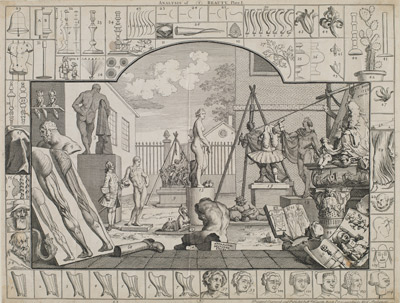 Drawing after plaster casts taken from Roman sculptures became commonplace in artistic training and indeed has continued to some extent to the present day as evidenced by the Crouching Venus cast from the Glasgow School of Art.
Drawing after plaster casts taken from Roman sculptures became commonplace in artistic training and indeed has continued to some extent to the present day as evidenced by the Crouching Venus cast from the Glasgow School of Art.
The increasing popularity of printed images played a key role in the circulation of the ideal forms of antique sculpture across Europe. Prints as well as casts served artists both in the academy and in the studio as the reproducible means of diffusing a canon of perfect classical forms.
The prints show artists learning by copying after plaster casts and figurines, including Venus, in order to train themselves in the forms of classical beauty before turning to the imitation of nature.
Image: Hogarth, The Analysis of Beauty.
Further Information
Further Information
 Picturing Venus is a collaboration with History of Art, University of Glasgow. It presents the results of a programme of research, Medial Translations in Renaissance Art, conducted by Dr Genevieve Warwick (now University of Edinburgh) and funded by the Arts and Humanities Research Council.
Picturing Venus is a collaboration with History of Art, University of Glasgow. It presents the results of a programme of research, Medial Translations in Renaissance Art, conducted by Dr Genevieve Warwick (now University of Edinburgh) and funded by the Arts and Humanities Research Council.
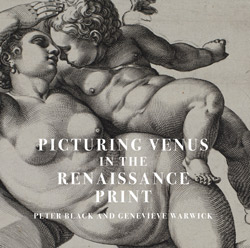 Picturing Venus in the Renaissance Print by Peter Black and Genevieve Warwick
Picturing Venus in the Renaissance Print by Peter Black and Genevieve Warwick
This new publication accompanies the exhibition and describes the development of imagery of the goddess Venus during the long Renaissance, presenting a selection of some of the remarkable old master prints in the collection of the Hunterian Art Gallery, University of Glasgow.
Available from the Hunterian Art Gallery Shop, price £14.99 (RRP £19.99).
Related Events
Picturing Venus Insight Talks
A series of lunchtime talks related to the Picturing Venus exhibition. Talks are given by experts from The Hunterian and the University of Glasgow and last approximately 10 minutes. Admission free - all welcome!
Please note that the talk Marcantonio and the sculptural print (Tuesday 25 March 2014) has been cancelled
Art and beauty in the Renaissance print
Date: Tuesday 15 April 2014
Time: 1.00pm - 1.15pm
Speaker: Genevieve Warwick
Location: Hunterian Art Gallery
Venus and victuals
Date: Tuesday 13 May 2014
Time: 1.00pm - 1.15pm
Speaker: Laurence Grove
Location: Hunterian Art Gallery
Great artists and printmaking in the Renaissance
Date: Tuesday 10 June 2014
Time: 1.00pm - 1.15pm
Speaker: Tom Nichols
Location: Hunterian Art Gallery
Picturing Venus Sunday Tour
Sunday 11 May 2014
12.45pm
Hunterian Art Gallery
Admission free - booking recommended
A special 30 minute curator led insight into the Picturing Venus display at the Hunterian Art Gallery. Limited to 25 places. Booking available but not required.
Picturing Venus Salon des Refusés
Friday 30 May 2014
2.00pm - 3.00pm
Hunterian Art Gallery
Admission free - booking required
An opportunity to visit the Hunterian Art Gallery Print Room and explore material that did not make it into the Picturing Venus exhibition. Limited to 12 places.
Venus Reflections Evening Lecture and Wine Reception
Wednesday 4 June 2014
5.30pm – 8.00pm
Hunterian Art Gallery
Free - no booking required
At this special evening lecture, exhibition curators Dr Genevieve Warwick and Peter Black discuss the Picturing Venus exhibition and give their ‘Venus Reflections’.

